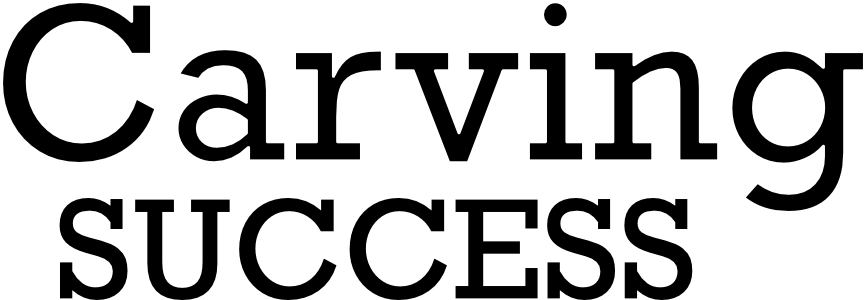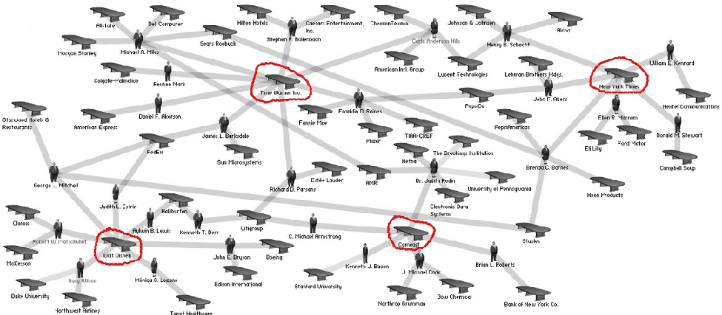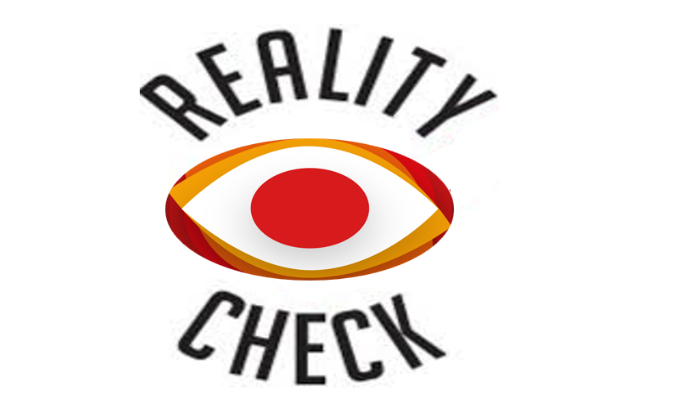“Interlocking directorates” is a concept that is not given enough importance for performance enhancement both within and outside organizations. It can be applied across the board from MSMEs to large corporations and is found to be useful at the individual level for career progression as well as for business performance enhancement and goal achievement.
Links:
- https://en.wikipedia.org/wiki/Interlocking_directorate
- https://hbr.org/2007/01/how-leaders-create-and-use-networks
“Interlocking directorate”, the concept and what it means
Interlocking directorate refers to the practice of members of a corporate board of directors serving on the boards of multiple corporations. Two firms have a direct interlock if a director or executive of one firm is also a director of the another and an indirect interlock if a director of each sits on the board of a third firm. The example above is a network diagram showing interlocks between various U.S. corporations/institutions, and four major media/telecom corporations (circled in red are: Time Warner Inc; NY Times, Walt Disney; Comcast).
A table from a brief study of leading business leaders (India – 2015) below brings out 2 degrees of separation in director interlock influence.

Tata Group a startup in 1868 is a global enterprise, operating companies in ten business verticals from consumer products to aerospace today. 66% of Tata Sons is owned by trusts which accounts for $106 billion in revenues in 2019-20. The combined market cap of Tata companies was $123 billion (INR 9.3 trillion) as of March 31, 2020. The group has more than 750,000 employees. Ratan Tata was chairman of Tata Group, from 1990 to 2012 and continues to head its charitable trusts.
While interlocking strategies used for goal achievement at the directorate level are normally discussed, it is observed that similar strategies are in practice informally across levels. Middle, senior, and top management use Interlocks (generally termed as network connections) to allow for better cohesion, coordination, and collaboration. This is in addition to the unified power of the interlocked executives. Interlocked executives increase their influence by exerting power as a group for common goal achievement. (Chambers of commerce and government).
Middle-Level Executives generally build interlocks at the operational level. The connection is mostly across functions to iron out differences due to personal agendas, contradictory goals, and others. (e.g., Finance – cash flow; Sales – more stock availability for better deliveries; Inventory – more inventory turns; Purchase – larger order size for better discounts). Interlocks also help to manage special situations that require mutual trade-offs better. Internal organization interlocks are sometimes called “Managing the Ecosystem” or “Managing Partnership Priorities” as discussed in my book “Carve your Own Path to Success”.
YouTube: Establishing Interlock Between Marketing, Sales, and Product: https://www.youtube.com/watch?v=UNakhoQJhLM&feature=emb_title
A case study in sales connectivity: https://www.kellogg.northwestern.edu/faculty/uzzi/ftp/teaching%20materials/Example_std_papers/LeadershipNetworks_EMP70.pdf
Senior Level Executives generallybuild interlocks at the business development level. The connections are mostly across customers, collaborating partners, vendors, and even competitors. The interlocks directly help business development by creating a better understanding with more disclosure to arrive at mutually beneficial solutions. (e.g., Knowledge sharing, mutual resource blending, and balancing and execution plan adjustments)
Top Management generally builds interlocks to facilitate strategic business interventions. The connections mostly cover influencers in the regulatory, economic, political, technology, environmental, and market spheres. These persons are used for information gathering and to influence decisions that lead to better strategies for goal achievement. (e.g., Import and export regulation changes; Overseas work visas; Industry digitization trends; Climate change and labor regulations; government incentive schemes for business)
General Examples:
- IT vendors track customer CIO job transitions through relationships built during training, projects, and alumni
- Suppliers maintain multilevel client engagement connects to sort out issues at different organization levels
- Competitors work together across different territories and market segments to optimize returns
- Hardware and software vendors collaborate or partner for joint bids
- Industry and sector business groups work together to influence government regulations
The interlocking concept is well known and mechanisms are in place, either formally or informally. However, the level of interlocking practice is limited and mostly applied in a reactionary manner. An analogy that could be considered is ‘peripheral vision’ a term used in optometry (Peripheral vision is described as everything you can see just outside of your direct line of sight). A question would be: How well are we using or working on enhancing our business peripheral vision to enhance business performance achievement?
Current Day Interlocking Mechanisms
Today interlocks are analyzed with bigger databases and sophisticated network programs. There are large databases with matrices that contain information on the linkages between persons and groups. Many complex analytical tools are being used to assess different aspects of corporate/organizational networks, based on common directors, or interpersonal/social networks based on shared board memberships. General information links on tools: https://insights.diligent.com/boardroom-technology/importance-interlocking-directorates-software
Some questions for reflection
- Managing interlocks at senior levels, whether it is internal or external, is a key factor for success.
- Can MSMEs and large conglomerates use interlock mapping methodologies to expand customer bases?
- Can large conglomerates use this mapping to build synergy within group companies and divisions?
- Are we using available tools to map networks of our competitors, customers and vendors?
- Do we have specific people, in our organization who are even partially responsible for mapping?
- Are we organized in such a manner that we regularly allocate time for assessing interlock status?
These questions apply to most executives and organizations. It is not difficult or costly to map and monitor interlocks, but it needs a change of mindset. One needs to experience the benefits of interlocking to believe.
There is much material on interlocking easily available on the net. This article is a thought trigger towards those interested in using or refining interlocking strategies that lead to higher levels of goal achievement.
Alan


